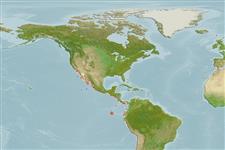Actinopterygii (ray-finned fishes) >
Perciformes (Perch-likes) >
Chaetodontidae (Butterflyfishes)
Etymology: Johnrandallia: After John Randall, marine biologist, Bishop Museum of Hawaii; he worked in systematic ichthyology with fishes of Indopacific region.
Environment / Climate / Range
Ecology
Marine; reef-associated; depth range 6 - 40 m (Ref. 9286), usually 6 - 12 m (Ref. 9286). Tropical, preferred ?; 40°N - 10°S, 120°W - 70°W
Eastern Pacific: Gulf of California to Panama, including the Cocos, Malpelo and Galapagos Islands.
Size / Weight / Age
Maturity: Lm ? range ? - ? cm
Max length : 20.0 cm TL male/unsexed; (Ref. 9286); common length : 14.0 cm TL male/unsexed; (Ref. 55763)
Dorsal
spines
(total): 11 - 12;
Dorsal
soft rays
(total): 24-25;
Anal
spines: 3;
Anal
soft rays: 18 - 20. Body deep, compressed, and disk-shaped; dorsal profile of head steep and concave; snout pronounced; teeth very small and se in a comb-like band; base of pelvic spine with an axillary process; lateral line complete, extending over caudal peduncle; body yellowish; snout with a dark stain; eye bordered with black; posterior edge of operculum, base of pectoral fins, nape, and dorsal border (at base of dorsal fin) black (Ref. 55763).
Often in large schools (Ref. 5227) over coral and rocky reefs (Ref. 9286). Feed on algae, gastropods, and small crustaceans (Ref. 9286). Pick parasites from larger fishes like Paranthias colonus and Mulloides dentatus (Ref. 28023). Oviparous (Ref. 205). Form pairs during breeding (Ref. 205).
Life cycle and mating behavior
Maturity | Reproduction | Spawning | Eggs | Fecundity | Larvae
Form pairs during breeding (Ref. 205).
Schneider, M., 1995. Chaetodontidae. Peces mariposa. p. 1000-1003. In W. Fischer, F. Krupp, W. Schneider, C. Sommer, K.E. Carpenter and V. Niem (eds.) Guia FAO para Identification de Especies para lo Fines de la Pesca. Pacifico Centro-Oriental. 3 Vols. FAO, Rome. (Ref. 9286)
IUCN Red List Status (Ref. 115185)
CITES (Ref. 94142)
Not Evaluated
Threat to humans
Harmless
Human uses
Aquarium: commercial
More information
ReferencesAquacultureAquaculture profileStrainsGeneticsAllele frequenciesHeritabilityDiseasesProcessingMass conversion
Tools
Special reports
Download XML
Internet sources
Estimates of some properties based on models
Phylogenetic diversity index (Ref.
82805): PD
50 = 1.0000 [Uniqueness, from 0.5 = low to 2.0 = high].
Bayesian length-weight: a=0.02754 (0.01654 - 0.04586), b=3.09 (2.94 - 3.24), in cm Total Length, based on LWR estimates for this species & (Sub)family-body (Ref.
93245).
Trophic Level (Ref.
69278): 3.0 ±0.44 se; Based on food items.
Resilience (Ref.
69278): High, minimum population doubling time less than 15 months (Preliminary K or Fecundity.).
Vulnerability (Ref.
59153): Low vulnerability (15 of 100) .
